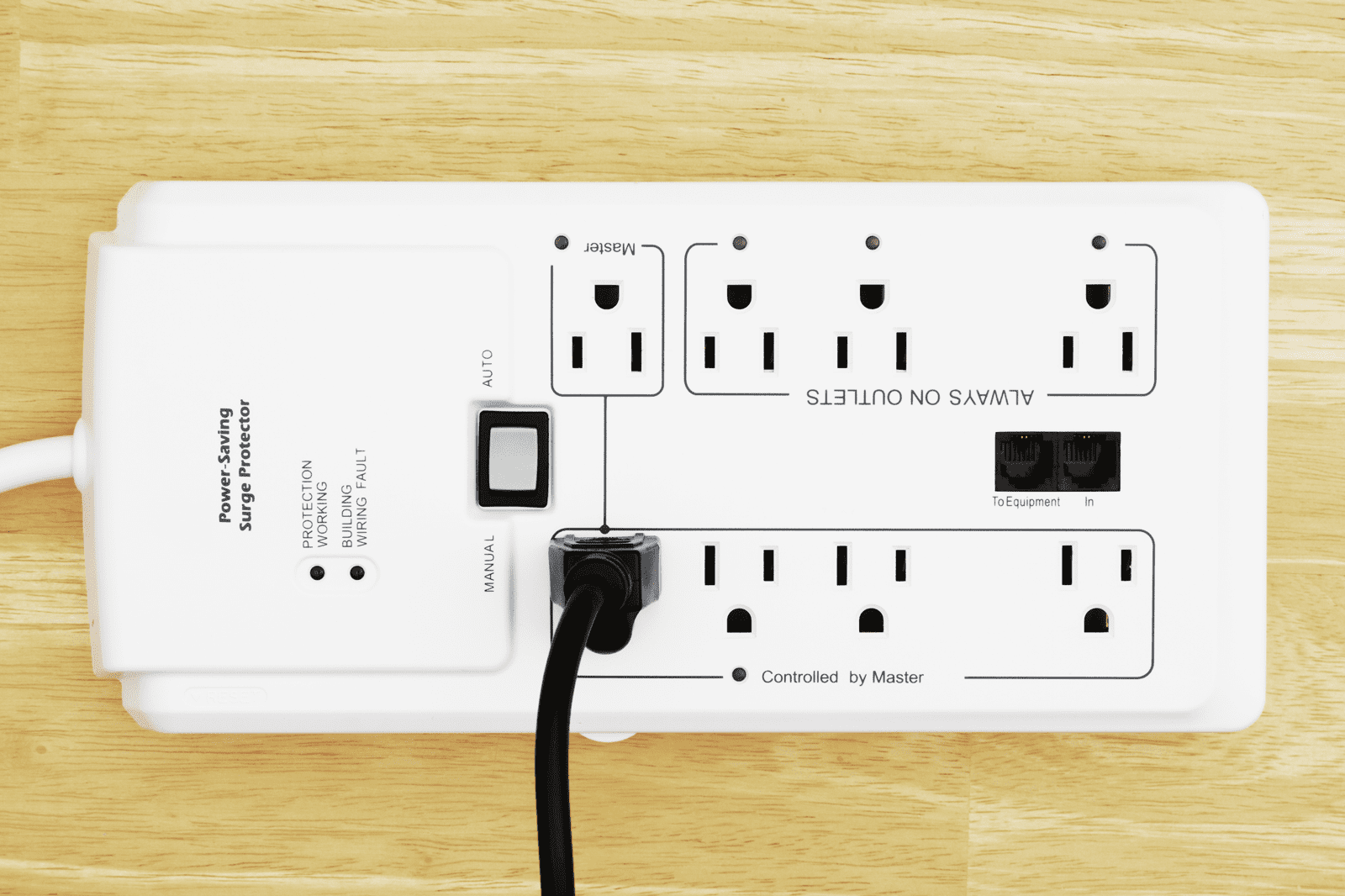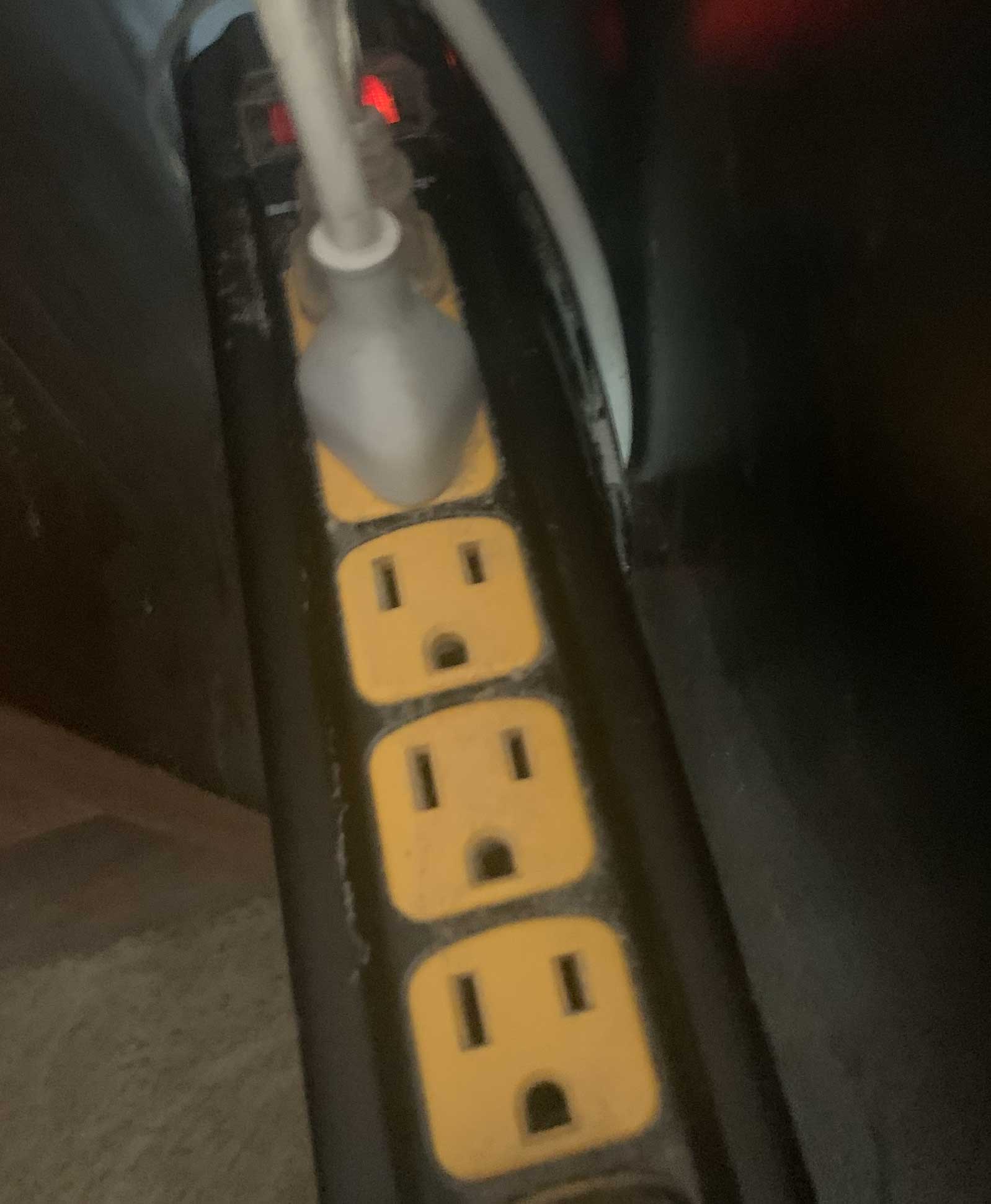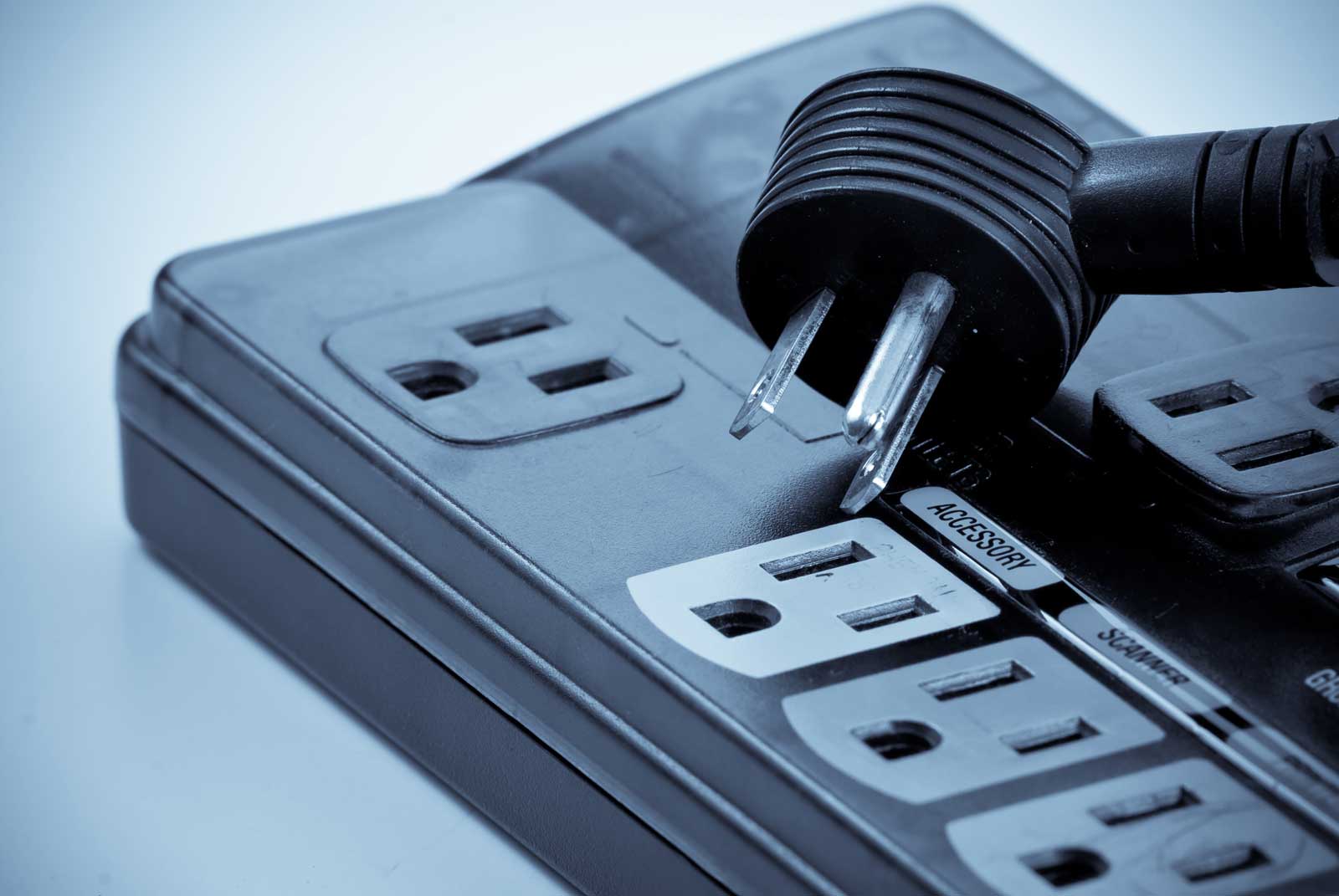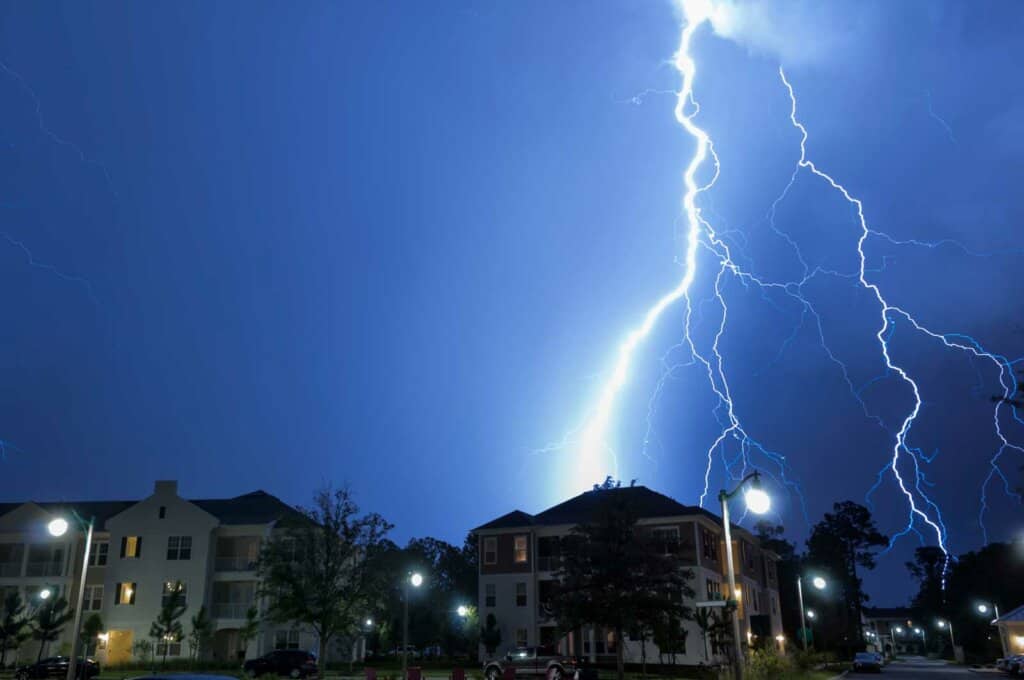Ever see those surge protectors that also have coaxial cable protection?
I have to admit, the first time I saw a surge protector with coax connections, I was completely confused – as if I was missing something that I should be doing.
I was left wondering: “why do these surge protectors have cable connections? Am I missing something?”
Some surge protectors have connections in and out for coaxial cable to prevent damage that can come from a power surge or a lightning strike overloading your system by sending too much current into your connected electronic equipment, in the same way that the electrical outlets are protected.
Indeed, I had missed something. Something big.
And expensive.
One time when I lived in an older apartment, I had a lightning strike in my general area that travelled through the lines in my house and blew my modem and my router.
Thankfully, all my connected equipment – my computer and all the other electronic devices in my office – were protected behind surge protectors. But not my cable.
It really sucked and was a costly oversight on my part.
If I’d known that I could’ve prevented that by passing all my connections through a surge protector, I’d gladly have done it.
I can’t say for certain that it came through my cable line, but by process of elimination, things were certainly pointing that direction.
So why do surge protectors have these cable connections?
Do they work?
Are they necessary?
Below, I’m going to unpack all this for you so you know everything you need to know and to figure out whether this kind of surge protection is something you need for your residence.
Real quick: before we get too far along here, if you want to get more great ideas for your gaming room or home office and connect with other home office hackers to make your space the best join my free private Facebook group, Home Office Hacks here.
Will A Surge Protector Really Protect Coaxial Cables?

Surge protectors can be helpful, but only if they’re installed correctly.
The cable TV surge protection modules on the power strip may or may not be able to help you. Surge protectors rely on having a good ground connection to divert the surge current.
The National Electrical Code (NEC) is a system of standards for the safe installation and deployment of electrical wiring in the U.S.
And part of that code details how coaxial cables are to be grounded.
The NEC requires that coaxial cables are to be connected to a grounding block on the outside of the building structure, positioned closely to where the coaxial cable enters the structure.
That’s the requirement, and while it’s not necessarily a proper surge protector, it is a path to the ground that helps mitigate a lighting strike or other catastrophic electrical failure, like when a power line goes down and lands on the roof of a house.
So there’s already some grounding in place, just by the NEC requiring that the coaxial cable be grounded at its point of entry into the home.
However, not all buildings – homes, apartment complexes, condominiums, etc – are up to that standard.
In addition, it could possibly be up to code, but you simply have no way of knowing without hiring an electrician to come out and do an inspection, and that can be expensive.
In these kinds of situations using a surge protector with a coaxial connection option is a safe bet.
How Does A Coaxial Module On A Surge Protector Work?
Coaxial modules on surge protectors seek to guard your expensive electronic equipment in a similar way that a regular electrical surge protector does.
It’s important for you to understand, just because you have a surge protector for some of your electronic devices, that doesn’t mean that you’re 100% in the clear when it comes to potential disaster for other items.
Think about it this way:
Essentially, surge defense attempts to either absorb or prevent power coming into your devices.
Good absorption protection allows electric current to flow at the lowest feasible voltage with the quickest response time and will be capable of absorbing the needed energy without breaking.
Good blocking protection will effectively stop the energy by blocking quickly and tripping a breaker that shuts off flow similar to the way a fuse does.
When a surge hits the module, the internal circuitry senses the problem and immediately opens up an external circuit path through the coaxial port to bypass the surge.
This prevents any harm from occurring to the electronic equipment connected to the surge protector.
Why Do Surge Protectors Have Coax In & Out?
The main reason that you will see surge protectors that also have coax cable connections is to protect your connected hardware from electrical surges caused by power surges and lightening strikes.
A power outage or lightning strike can cause an electrical surge which travels through coax cable and damages connected devices.
That means it can not only hit your cable box, or cable modem, but also the devices connected to those devices too.
Power surges can occur due to faulty wiring or equipment failure.
These events can damage any device connected to the coax cable including televisions, computers, routers, modems, etc.
Surge protectors are designed to protect against these types of events so that your devices aren’t damaged.
What Are The Benefits Of Using A Surge Protector With Coaxial Cable?

There are many benefits to using a surge protector with coaxial cable.
First, it provides a reliable means of protecting sensitive electronic equipment from surges and lightning strikes that could potentially come through your cable line.
It provides a convenient means of protecting multiple devices simultaneously and a means of avoiding damage to your electronic equipment.
Some will say this is unnecessary because the grounding that’s required by code, as mentioned previously.
However, we can’t always be guaranteed that our residence is up 100% up to code, or current with the standard, especially if it’s an older residence.
In many instances, people rent an apartment or house, and are not knowledgeable about the quality of the wiring and installation of their cable system.
If you’re one of those people like me who own their own cable modem, you don’t want to risk damaging your electronics.
A surge protector with a coaxial port is a great option for those situations.
You’ll have peace of mind knowing that if a surge should hit your cable line, and it’s not grounded properly, the spike in current can be safely mitigated by the surge protector.
Does Passing Your Coax Cable Through A Surge Protector Compromise The Signal Strength?
In some instances, passing your coaxial cable through a surge protector equipped with coaxial modules can cause a degradation in the strength of signal sent to your display and cause pixelation, noise, and other kinds of electric interference that will result in a less-than-desirable viewing experience.
That’s the short answer.
The longer answer is, that it depends.
It depends on two primary things:
The strength of signal you’re getting from your cable provider, and the quality of the surge protector you’re using.
In older homes and apartments, the strength of signal coming from your cable company are notoriously weak.
For example, several years ago while living in an apartment our cable signal was so weak due to the old wiring and capacity of the system they put in place, it was unable to pass a high-quality high-strength signal to our apartment.
(Ironically enough, this is the same apartment where I had the lightning strike take out some of my equipment – true story!)
So Comcast had to come out and run an entirely new line directly to our apartment (after much griping and complaining) to solve the issue.
But if you’ve got a good signal getting to your home office, and yet you have a low-quality, bargain basement surge protector, it’s almost certain that you’re going to experience signal degradation.
Conversely, if you have a good signal, along with a high quality surge protector, then you should be ok.
Should I Run My Coax Cable Through A Surge Protector?

Should I run my coax cable through one of these things or not?
There are varying opinions.
Some people believe that it’s a bad idea unless the surge is a component of a whole house system and uses a gas discharge.
Others think that it’s not necessary because in some scenarios, like when you’re living in an apartment a whole house system isn’t even a realistic option.
Some cable service technicians will swear that running your cable signal through a surge protector will degrade your service by introducing noise and other interference causing less than optimal performance for your electronic devices.
Others are of the opinion that when you use the right surge protector that’s properly rated, there’s nothing better for your system that you can do.
The bottom line is this:
No system or approach is foolproof.
Taking sensible and reasonable precautions is always a good idea as long as it doesn’t hamper performance in any noticeable way.
Any Other Reasons Would I Pass Coax Cable Through Surge Protector?
A legitimate cause for concern would be if you’re using a rooftop antenna, and your equipment is connected via a coax cable.
These are instances where you’re using a digital antenna, or something along those lines to receive broadcast signals over the air.
If you’re using such a device, then you need to make sure that the coax cable is protected against surges.
Otherwise, you could be subjecting your equipment to damage from surges that may occur during normal operation that bypass the grounding standards that would be common to coaxial cable installation for a traditional cable service.
How Do You Install A Surge Protector With Coax Cable Connections?
If you plan on installing a surge protector with coax cable connections, there are several things you should know before doing so.
First, make sure that your surge protector has enough outlets to accommodate all of your connected devices.
Second, if your surge protector is also a uninterruptible power supply (UPS) and also a you plan on using this surge protector to provide backup power, then you’ll want to ensure that it has enough capacity to handle a full power outage.
Third, you’ll want to keep in mind that surge protectors are typically rated based on their ability to withstand a certain amount of peak voltage.
For example, a surge protector may be rated at 600 volts, meaning it can withstand up to 600 volts of AC (alternating current) electricity.
However, if you connect two surge protectors together, each one would only be able to withstand 300 volts of AC electricity.
As a result, you could potentially overload either of them or even both of them.
To avoid this situation, you’ll want to install a single surge protector that can handle the combined load of multiple devices.
Finally, don’t forget to check the surge protector manual for proper grounding instructions.
You’ll want to follow the manufacturer’s guidelines exactly otherwise you risk damaging your electronics.
Why Do Surge Protectors Have Ethernet Ports?
Just like some surge protectors have coaxial cable connections, some also have connections for ethernet cables.
The protection for these kinds of connections work in a similar way as those of the coaxial connections.
By placing the surge protector between your modem and the router, and your modem gets hit in a lightning strike, the objective is to keep your router from getting fried even if your modem was damaged by the strike.
Next Steps
Want to join others who are creating the most amazing home offices and get more tips, tricks and hacks on how to make your home office the best it can be?
Join my brand new free private Facebook group, Home Office Hacks to connect with other home office hackers to make your space the best!
